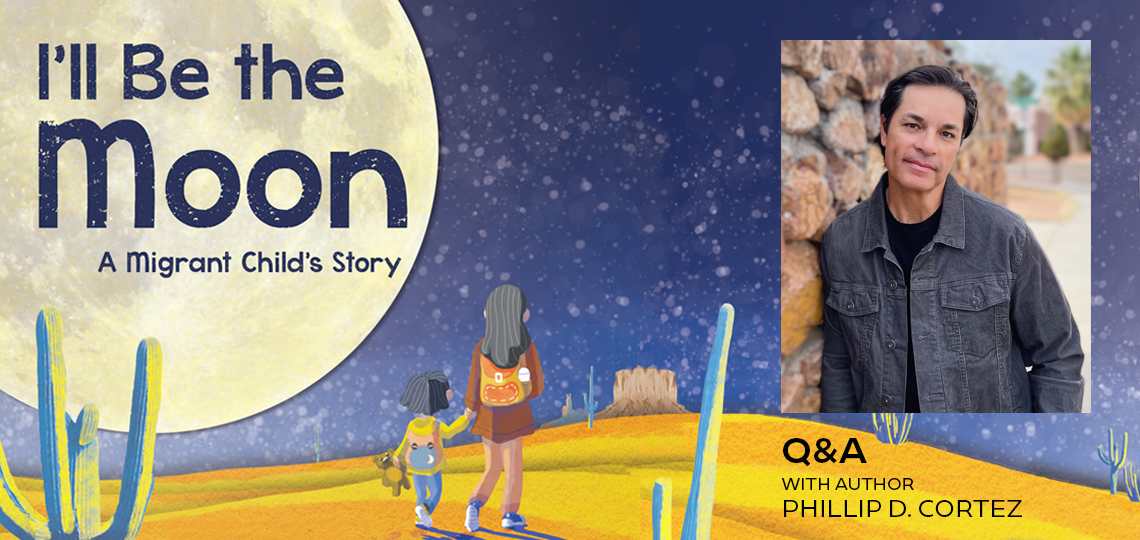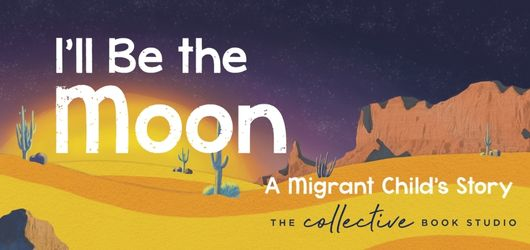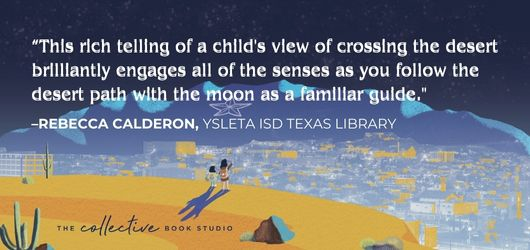Meet Phillip D. Cortez, Author of I'll Be the Moon

Executive Editor Matt Sutherland Interviews Phillip Cortez, Author of I’ll Be the Moon
Where lies the secret to nurturing children with empathy for people of different races, ethnicities, and beliefs? Where lies the source of love?
In I’ll Be the Moon, (reviewed in Foreword‘s November/December issue) Phillip Cortez tells the story of a mother and daughter crossing a moonlit desert to reach the child’s beloved father. With spare language, written in the voice of his young teddy-bear carrying protagonist, Phillip showcases the courage of the immigrant seeking a promised land. In the age of climate change, migration is the story of our time—one that will test the bonds of tolerance needed to hold families, nations, and societies together.
Foreword’s Matt Sutherland connected with Phillip to talk about his hopes for the book, his connections to the plight of immigrants, and lessons to be gleaned from the moon.
With so many factors influencing the movement of peoples around the world—climate change, economic disparity, political violence, the thousand faces of desperation—migration may be the single most important issue of the twentieth-first century. Please tell us why it is important to you? Might you, perhaps, have a personal immigration story: family or friends, perhaps?
We all come from somewhere, so, in essence, this is everyone’s story. And you’re right, it’s one of the most important stories of our time. The movement of people for a better, safer life has been going on since the beginning of time. But I began to pay much closer attention to it when children began making the treacherous journey to the US-Mexican border by themselves. Living in El Paso, this was happening right in my own backyard. That made it personal to me.
The story follows an adolescent girl and her mother alone “on our long journey north … across a desert sea” at night, to where she hopes to find “my father again and feel the stubble on his cheek.” And this little girl shows no fear. “The moon is bold,” she says, and “I, too, will be bold and brave the night, until we see a string of light flickering in the distance, dancing in freedom across a horizon of purple mountains touching the sky.”
We hear such terrible stories about migrant journeys in the media and elsewhere. Can you talk about the fear-courage message you want to send to your young readers? How much of a role does the teddy bear play in her backpack?
I’d like to think that the teddy bear serves as a subtle reminder that despite the massively grown-up (and dangerous) act of trekking across a Mexican desert, she is still a kid. But rather than a fear-courage message, the heart of this story is all about a child’s love for her dad and her yearning to be with him again. It’s clear that people are willing to go through great risks to ensure a better life and/or reunite with their loved ones. This includes long and dangerous journeys that migrant women and children take. The little girl chooses to be bold, like the moon, but it’s ultimately love that keeps her feet moving forward on her journey.
Honeysuckle aromas on warm breezes, saguaro cactus shadows, the moon and stars and setting sun, galaxies and constellations; so many references to the unblemished natural world. In your collaborative discussions with illustrator Mafs Rodriguez Alpide, did you stress a certain vision of the landscape you were hoping to see on the page? What was it like to work with Mafs?
I wanted the illustrator to have the same context and understanding of these characters, combined with a similar perspective. So, it only made sense that the illustrator needed to be a female Mexican artist. And with Mafs I lucked out BIG TIME. I sent her pictures of the desert landscape here in El Paso and she took that ball and ran with it. I loved her use of mixed art, color, and richness on every page. My only real criteria—and this is the case with every illustrator I’ve ever worked with—was to own the story as if you wrote it. I’m so thankful that I came across her Instagram page one day!
Let’s talk about the moon. A phoenix, you say, bringing light to the shadows: “she rises behind us despite not knowing what happens next.” And we can certainly imagine the many millions of Central Americans walking north, mostly at night to avoid detection, relying on the moon for light and inspiration. Can you talk about the book title, the role the moon plays in this children’s picture book, and why you think the moon is such a beloved heavenly body?
I can still vividly recall the moment that the first spark of a story entered my mind. It was late afternoon when the horizon is golden, but the night sky is starting to make its presence felt. I had taken two of my daughters fishing along the banks of the Rio Grande near my mother’s house (she, too, joined us). I watched my mother helping my own daughter with her fishing line. And there was the moon, right above them. The term “Mother Moon” was the first thing that came to mind. It all flowed from there … like a river.
There’s a long (and tired) list of reasons many Americans wish to stop—or, greatly reduce—the flow of immigrants into the US, as you well know. But those reasons usually don’t hold up when examined closely, or when counterarguments are considered. What would you say to those “anti-immigrant” Americans to help open their minds?
I don’t mean to be too overly simplistic (because an entire dissertation can be written on this one question) but I go back to the premise that we all come from somewhere. In fact, that serves as the dedication at the beginning of the book. Sometimes we lose sight of this. We lose sight of how this country was built, who did the work (whether they were free or enslaved), etc. And when we lose sight of this, we lose a part of our empathy. And when we lose a part of our empathy, we lose a part of our humanity. We forget how much immigrants still contribute to every facet of our economy and our culture. The irony is that the majority of people who are “anti-immigrant” probably love themselves a nice plate of tacos with a side of guac and a smooth cerveza!
Science has shown that it’s human nature to be suspicious of unfamiliar people: including people of different race, ethnicity, and language, not just strangers. Which suggests that changing minds may be especially difficult. Do you think that instinctual fear of foreigners is a real factor in the immigrant debate?
Yeah, generally speaking, I agree that we’ve always kind of feared the unknown. This can apply in many ways, like being afraid of the dark or not knowing what lurks in the distance. As it pertains to this topic, we must remember that fear is a two-way street: someone who is afraid of the immigrant coming into the country is one perspective. But the immigrant child who’s traveling to somewhere new and different is also afraid of the unknown. Fear truly adds a layer of blurry to this topic. Maybe with less fear we can have more clarity on the issue—but without empathy and a sense of humanity, we won’t accomplish much in terms of any kind of reform.
Congratulations on a beautiful book, which now has a Spanish edition, as well. What’s next for you? Can we look forward to another book?
I appreciate the kind words! This has been such a great experience so far—and the book isn’t even out yet. I can’t wait for the Spanish edition to come out in January. In the meantime, I look forward to connecting with as many readers as I can. And you better believe I’ll be writing and sharing something new very soon!
Matt Sutherland



